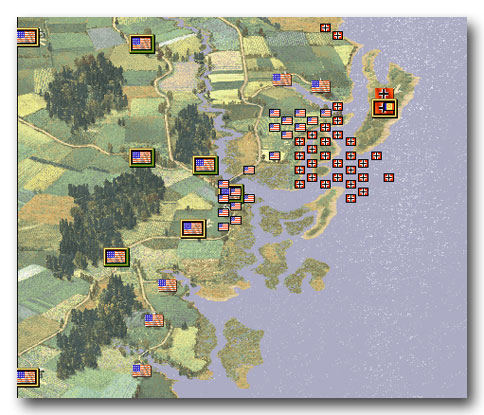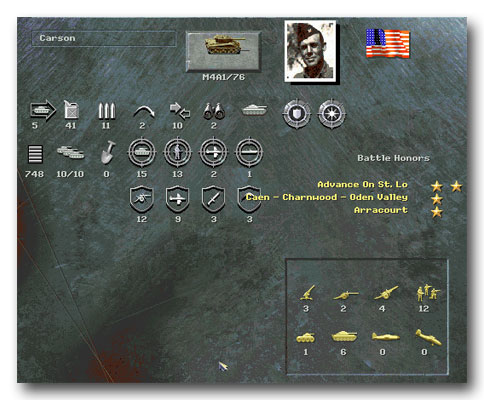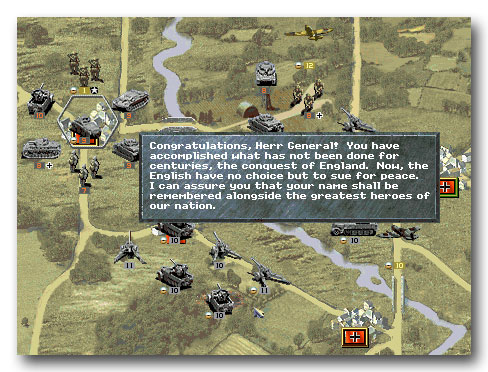
It’s a little known fact Panzer General, that classic turn-based PC wargame released by SSI in 1994, was actually inspired by a Sega Genesis game, Daisenryaku. In High Score! The Illustrated History of Electronic Games, Johnny L. Wilson noted SSI’s designers admired the Japanese console game’s fluid gameplay and the emotional hook of shepherding a core group of units from battle to battle. Those elements would naturally be emphasised in Panzer General then later refined in the 1997 sequel, Panzer General II. Both titles are not only considered classics of their genre but are among the best PC games ever released.
(Over a decade later, Firaxis will pay Panzer General the ultimate compliment by incorporating its gameplay elements into the latest Civilization title.)
The Panzer General games are primarily notable for being wargames for the masses. The grognards had computer equivalents to their impenetrable, persnickety boardgames, of course — players of Gary Grigsby’s Pacific War were known to consult a two-page checklist before making each move — but it took a while for wargames to become accessible enough to appeal to the mainstream gamer.
The Panzer General games were certainly easy to get into but crucially, this accessibility was achieved without making the game shallow. Fiddly, extraneous details may have been simplified, consolidated or expunged but make no mistake, punching through defensive lines to capture objectives deep within enemy territory will still ultimately require tactical nous and canny use of materiel.

Those who need further convincing of the enduring appeal of the Panzer General game mechanics need only visit Good Old Games to get the recently re-released Panzer General II, arguably the finest game in the series.
The GOG version includes PDF versions of the excellent 100-page manual as well as the unit info tables but omits the leader ability descriptions (which, to be fair, were also missing from the original release). On the plus side, GOG has included a custom executable (PG2UK220.EXE) necessary to run the more ambitious user-created campaigns and mods.
The 13-year-old game runs well on Windows XP systems but Windows Vista and Windows 7 users may want to consult this GOG thread for a workaround for crashes. Unfortunately, there’s no workaround to get the game running in a window. While the painterly graphics of the battlefield and units remain beautiful in the original 640×480 resolution, blowing them up to 1680×1050 on large monitors does them little service.
If the presentation and interface seem a little lacklustre and a little dated today, the gameplay is as riveting as it was back in 1997. PGII has that one-more-turn pull characteristic of the best turn-based games making it almost impossible to put the game away mid-scenario.
Even between battles, the game remains absorbing as there are tough choices to be made. Should resources be spent on improving veteran units or acquiring inexperienced recruits? Should the taskforce attempt to achieve air superiority or rely on air defences? More artillery pieces or additional tactical bombers? The player will need to think hard about taskforce composition because decisions and mistakes made early in a campaign could have serious ramifications in later battles.
Considerable thought must be put into tactics as well because the player is given ample reason to avoid callously throwing away lives. As units gain experience, they improve both their deadliness and survivability, making them much more valuable as the campaign wears on.
To further distinguish battle-hardened units from fresh-faced recruits, PGII introduced leaders with random abilities that could dramatically increase the effectiveness of veteran units. A tank commander with the Devastating Fire ability could urge his unit to fire twice in a single turn, an infantry unit leader with the Infiltration Tactics ability will be adept at city assaults.
The upshot of this is when the situation calls for the heroic sacrifice of a member of the old guard, it is never a decision that is taken lightly.

In battle, PGII is admittedly more abstract boardgame than exacting simulation. The player could, for instance, exploit the Zone of Control rule to severely limit an enemy unit’s movement, which is particularly absurd when aerial units are involved. Despite that, PGII retains enough flavour of World War II combat to be satisfying.
Capturing a well-defended town is best accomplished through combined arms — air power to soften defences, artillery to pound the well-entrenched defenders before the sappers are sent in to finish the job. The player’s first encounter with the T-34 in the German campaign will be as much of a shock as it was historically for the Panzertruppen. Playing as the Soviets, the player will find even battered and bruised Tigers and Panthers are a force to be reckoned with thanks to the long range of their main guns.
Yet when the game deviates from history it can also be immensely gratifying. If reenacting the German blitzkrieg in France is satisfying, exploring what-if scenarios such as the German invasions of England and the US (the campaign rewards for outstanding performances in the historical battles) is tremendous fun as they let the player indulge in the fantasy of surpassing Rommel and von Manstein.

Achieving victory in battles is not difficult as the AI is competent at best defensively and easily embarrassed while on the offensive. It could be commended for its ruthlessness in eliminating vulnerable and weakened units but on the whole, the AI needs the special advantages accorded to it. (Its ability to boost damaged units to overstrength levels mid-scenario is particularly aggravating.)
Time is the greater foe and the challenge in the game lies in achieving objectives as quickly as possible. The twin considerations of a strict timetable and the need to preserve veteran units for future battles seem irreconcilable. The lightning-quick advances necessary for brilliant victories require putting units in considerable risk while cautious tactics to ensure minimum casualties eat up precious time.
The final few turns before the deadline for a brilliant victory are tense and thrilling — perhaps PGII’s gameplay at its best. Low on ammo and fuel, your forces are overextended and strung out across the map as you prepare to make a final desperate push for that last victory objective. There are no more reinforcements. There is no reserve. This is it. And it is at this precise moment the enemy chooses to launch an unexpected counteroffensive. It is not only the outcome of the battle that hangs in the balance; your decisions at this critical moment could dramatically alter the course of history itself.
Your orders, Herr General?
